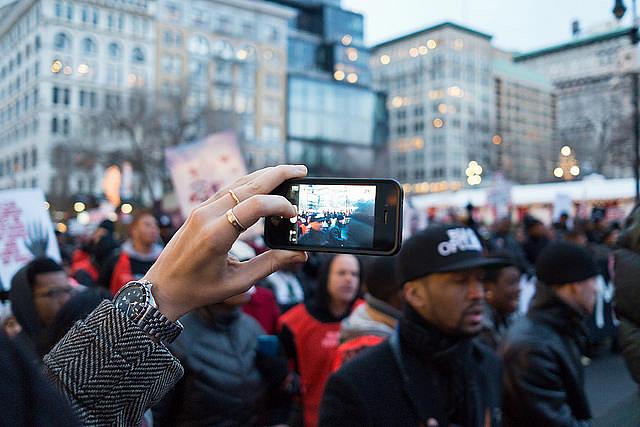When does the need to inform cross over to sensationalism and desensitization?

Less than 24 hours after Alton Sterling, a 37-year-old black man and father of four, was fatally shot by police officers in Baton Rouge, Louisiana, the image of his lifeless body could be found splayed all over the internet.
Soon after, it was front page news.
The video of Sterling being killed - multiple shots at point blank range- seemed to be on endless replay for days to come, shown by news and social media sites.
Two days later a New York Daily News cover featured a bloodied Sterling, shot up and sprawled out in a parking lot, his open eyes staring blankly at the sky. The headline read: “His hands were empty: Cops killed Alton Sterling despite his being pinned to ground and never pulling gun.”
Eager to get the image out, the paper even provided a sneak peek of the controversial cover the night before, posting it on Twitter and drawing both ire and appreciation from viewers. The responses ranged from:
.@NYDailyNews DELETE THIS NOW. STOP USING BLACK DEATH FOR YOUR ECONOMIC GAIN.
— Brotha B (@BlakeDontCrack) July 7, 2016
And:
@NYDailyNews Tasteless. Not like I expected better but really? Leave him some dignity.
— Cristin McGrath (@CristinMcGrath) July 7, 2016
To votes of support, with one viewer even saying:
And to all those who think it's "tasteless"? If that was my father I'd want that picture on a billboard. @NYDailyNews
— Wendy Harmer (@wendy_harmer) July 7, 2016
And another:
@NYDailyNews Thank you for making sure as many people see this as possible.
— John Reynolds (@jpreynolds88) July 7, 2016
In our digital age, images, both wanted and unwanted, can be instantly distributed across millions of screens. How much is too much? The modern combination of media photography, police body cams, and smartphone cameras have led to unprecedented levels of exposure to images of violent black deaths. As journalists, what role do we play in distributing these images? Are we slowing down and hitting the pause button long enough to reflect on the impact of this carnival of death and cheapening of life?
Quinyetta McMillon, Sterling’s wife, provided a personal perspective during a televised press conference. As McMillon spoke, her son wept loudly beside her.
My son … is 15 years old,” she said. “He had to watch this as this was put all over the outlets and everything that was possible to be shown.
The day after Sterling’s shooting, Diamond Reynolds, the girlfriend of Philando Castile, used Facebook Live to capture the immediate aftermath of her boyfriend’s murder at the hands of another police officer, this time in Falcon Heights, Minn. Social media feeds, nightly news segments and countless websites flooded the internet with the graphic video footage of Castile, slumped over and bloodied, slowly dying as his girlfriend narrated the injustice that had occurred, with her four-year-old daughter in the back seat.
The images are becoming too numerous to catalogue. The photo of Trayvon Martin’s lifeless, teenaged body lying in the grass. The image of Michael Brown’s body, left to lie for four hours on the street where he was fatally shot in Ferguson, Missouri. Telling as well are the images that are not seen, such as the killings of Black women and trans individuals, who don’t have a media-ready image or video that can be used for clickbait.
What are the impacts of these images on the loved ones and communities of victims? What level of mental trauma is wrought upon the Black community from the viewing and reviewing, sharing and resharing of images of Black death? It is now a well-established fact that racial violence by law enforcement is a public health problem. CNN provides an excellent summary of the stance of many in the medical profession, citing the American Academy of Family Physician’s 2015 resolution to state that excessive use of force by police “poses a serious ongoing public health issue that disproportionately affects minority communities.”
But what of the mental trauma of seeing those you love, or even those who look like you and the people you love, killed again and again in an unending reel? While these images, often taken by civilians on the scene, have become powerful forms of documentation against the discrimination and violence faced by black Americans in this country, is there an ethical limit to the use of such footage by the media? Where does the need to expose injustices and inform audiences cross over into sensationalism, desensitization, and dehumanization?
Dr. Sherri Williams spoke to this point in a recent NBC News editorial, evoking the tragic story of Emmett Till, whose mother insisted on an open casket funeral after her son was brutally tortured and murdered for whistling at a white woman:
Mamie Till Mobley wanted the nation to see the photo of her son Emmett's bloated and beaten body after his 1955 lynching in Money, Mississippi,” Dr. Williams said. “That singular image documented the terrorism that black people experienced daily. It caused a profound shift. But what is the impact when the images and the videos become so numerous that we can barely match the victims with the incident of violence?
Photo by Phil Roeder via Flickr

